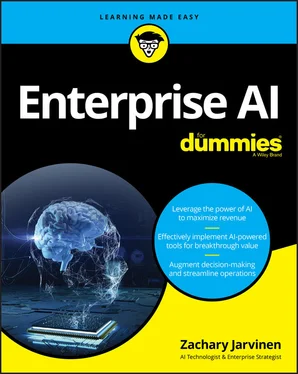Zachary Jarvinen - Enterprise AI For Dummies
Здесь есть возможность читать онлайн «Zachary Jarvinen - Enterprise AI For Dummies» — ознакомительный отрывок электронной книги совершенно бесплатно, а после прочтения отрывка купить полную версию. В некоторых случаях можно слушать аудио, скачать через торрент в формате fb2 и присутствует краткое содержание. Жанр: unrecognised, на английском языке. Описание произведения, (предисловие) а так же отзывы посетителей доступны на портале библиотеки ЛибКат.
- Название:Enterprise AI For Dummies
- Автор:
- Жанр:
- Год:неизвестен
- ISBN:нет данных
- Рейтинг книги:5 / 5. Голосов: 1
-
Избранное:Добавить в избранное
- Отзывы:
-
Ваша оценка:
- 100
- 1
- 2
- 3
- 4
- 5
Enterprise AI For Dummies: краткое содержание, описание и аннотация
Предлагаем к чтению аннотацию, описание, краткое содержание или предисловие (зависит от того, что написал сам автор книги «Enterprise AI For Dummies»). Если вы не нашли необходимую информацию о книге — напишите в комментариях, мы постараемся отыскать её.
, author Zachary Jarvinen simplifies and explains to readers the complicated world of artificial intelligence for business. Using practical examples, concrete applications, and straightforward prose, the author breaks down the fundamental and advanced topics that form the core of business AI.
Written for executives, managers, employees, consultants, and students with an interest in the business applications of artificial intelligence,
demystifies the sometimes confusing topic of artificial intelligence. No longer will you lag behind your colleagues and friends when discussing the benefits of AI and business.
The book includes discussions of AI applications, including :
· Streamlining business operations
· Improving decision making
· Increasing automation
· Maximizing revenue
The
series makes topics understandable, and as such, this book is written in an easily understood style that’s perfect for anyone who seeks an introduction to a usually unforgiving topic.
Enterprise AI For Dummies — читать онлайн ознакомительный отрывок
Ниже представлен текст книги, разбитый по страницам. Система сохранения места последней прочитанной страницы, позволяет с удобством читать онлайн бесплатно книгу «Enterprise AI For Dummies», без необходимости каждый раз заново искать на чём Вы остановились. Поставьте закладку, и сможете в любой момент перейти на страницу, на которой закончили чтение.
Интервал:
Закладка:
Foolish Assumptions Foolish Assumptions I am assuming that you, the reader, fall into one or more of the following categories: You have a college-level education, such as a bachelor’s degree, MBA, or professional certifications, or are pursuing a business degree. You read trade publications and books on business management. You possibly have leadership and/or IT skills, but not necessarily programming knowledge. You fall somewhere on the spectrum between:Business executive and decision-maker at a mid-sized to large organizationConsultant and strategic advisor, formal or informalAmbitious junior and up-and-coming employeeBusiness school or related student
Icons Used in This Book Icons Used in This Book As you read this book, you see icons in the margin that indicate material of interest. This selection briefly describes each icon in this book. Everybody likes a tip, a little inside knowledge about a good thing. A life hack. A hint about how to save time or money. How to make things easier. This icon marks the spot where the goods are buried. A few things are good to know, and remember, about how AI works. This icon reminds you to remember those things — and makes it easy to find them again if you forget to remember. This icon is the reverse of a tip. It tells you how to avoid the bad thing. You see this? Don’t do that. Once or twice for a second or so, the book gets down in the weeds, kicks over a rock to see what’s underneath. If you like that kind of thing, when you see this icon, keep on reading. If not, just skip it. You won’t miss anything you can’t live without.
Beyond the Book Beyond the Book To extend the experience beyond what’s in print here today, I’ve put together these additional resources: Cheat sheet: A quick reference to the major bullets and tables from the book. Feel free to print and post to your wall or simply glance at it when you need a reminder of some of the most fundamental concepts of Enterprise AI. You can find the cheat sheet by going to www.dummies.com and searching for Enterprise AI For Dummies Cheat Sheet . Updates: I've written this book to expose essential groundwork and use cases that will remain evergreen. That said, as this topic will likely only receive more prominence, not less, over the years to come, I also plan to publish updates, as applicable. They will be available on www.dummies.com as well by searching for Enterprise AI For Dummies. Additionally, input about this content is welcome directly through my site, www.zachonomics.com , where book-related talks and articles are also posted.
Where to Go from Here Where to Go from Here There’s no harm in starting at Chapter 1 and reading right through, but unless you want to learn how AI can be used in a wide array of vertical markets and horizontal applications, you will likely want to dip into the areas of most interest to you and save the rest for another time. Maybe you’ve noticed AI in the news, glanced at the headlines, skimmed a few articles, watched a video or two, but you’re still not completely certain that you know how it works and how you can use it. If so, before diving into the practical applications, start with Chapter 1 , which provides some background about why companies are turning to AI to solve their problems and takes you on a tour of the four pillars on which modern AI is built. You might have heard the term algorithm tossed about casually and wondered what one looks like. In that case, the last third of Chapter 1 is for you. It covers all the cool ideas, such as machine learning, deep learning, and text mining, to mention a few, not at a deep technical level, but at the level required to understand how you can use them to address your business challenges. If you are looking for real-life examples of how AI has been used in the past and how it is being used now to solve business problems, read Chapter 2 . If you want to explore what it takes to get an AI project up and running in your business, check out Chapter 3 . If you’d like to take a deeper look at how you can use AI in your market, flip to Part 2 . For each market, the chapters cover these areas: The challenges facing that market How AI can save costs, increase revenue, and support new business models A look under the hood to see the AI techniques that make it happen Specific use cases that allow you to leverage AI to grow your organization Part 3 looks forward to future applications of AI, as well as sets out a framework of guardrails, so instead of approaching the topic like a panacea, you are equipped with a grounding that will set you and your organization up for a successful implementation. Part 4 looks at ways AI will affect the coming decades and why AI is not the final answer for all your business issues.
3 Part 1: Exploring Practical AI and How It Works Part 1
Chapter 1: Demystifying Artificial Intelligence Chapter 1
Understanding the Demand for AI Understanding the Demand for AI If there is a universal constant in commerce throughout the ages, it is competition. Always changing, always expanding, always looking for a foothold, an advantage — whether from reducing costs, increasing revenue, or unlocking new, innovative business models. Similarly, while much discussion has taken place in the last few decades about the challenges posed by a global economy, international trade is not a recent phenomenon. It dates back at least to the Assyrians. Four millennia later, the goal is the same for the modern enterprise: establish a competitive advantage. However, the specific challenges to tackle are new.
Identifying the Enabling Technology Identifying the Enabling Technology Just as constant as the challenges posed by competition throughout the ages is the role of innovation in addressing competitive pressure. Four millennia ago camels were domesticated, and a few centuries later ships were launched to enable long-distance trade. In this new millennium, the continued pressure of competition has fueled advances in technology, particularly in the domain of artificial intelligence. Like the camel and the ship, AI enables those in business to go farther and faster, to respond to global pressure to reduce cost, increase efficiency, and accelerate the development and delivery of products. However, several enabling technologies had to reach maturity to create a foundation that would allow AI to realize the potential envisioned by the scientists at the 1956 Dartmouth Summer Research Project on Artificial Intelligence.
Discovering How It Works Discovering How It Works Artificial intelligence is a field of study in computer science. Much like the field of medicine, it encompasses many sub-disciplines, specializations, and techniques.
Chapter 2: Looking at Uses for Practical AI Chapter 2
Recognizing AI When You See It Recognizing AI When You See It Like good design, good AI is invisible. When done right, both remove some of the friction from daily life. In fact, you have probably been using artificial intelligence for longer than you realize.
Benefits of AI for Your Enterprise Benefits of AI for Your Enterprise Artificial intelligence offers significant benefits for a broad range of markets. The most noticeable is optimizing the workforce by increasing their efficiency and reducing the burden of manual tasks. AI is good at automating things you might feel bad about asking someone else to do, either because it is tedious, such as reading through reams of reports, or dangerous, such as monitoring and managing workflow in a hostile environment. In other words, AI can relieve workers from the part of the job that they like the least. In addition, when an algorithm produces results with high accuracy and predictability, mundane processes and routine decisions can be automated, thus reducing the need for human intervention in the paper chase of the typical enterprise and freeing workers to focus on tasks that increase revenue and customer satisfaction. AI thrives on data and excels at automating routine tasks, so those industries with a wealth of digitized data and manual processes are poised to reap large rewards from implementing AI. For these industries, AI can enhance the things you want to increase, such as quality, adaptability, and operational performance, and mitigate the things you want to reduce, such as expense and risk. This section provides a bite-sized overview of industries that can derive specific benefits from implementing AI. Later chapters explore use cases for each in depth.
Chapter 3: Preparing for Practical AI Chapter 3
Democratizing AI Democratizing AI For decades, artificial intelligence was the province of academics, scientists, and technicians with a highly specialized skill set. In the 1980s, some data scientists took the step from academe to commerce, applying AI to real-world problems and the development of expert systems. In the 1990s, commercial applications for AI expanded along with the Internet and the wealth of data it generated. Even so, any business wanting to capitalize on the power of artificial intelligence had to commit a serious amount of capital, not only for rare and expensive data scientists, but also for major-league processing power and data storage. More recently, full-powered AI solutions with simplified interfaces allow users to create and train models and produce reports and data visualization, reducing the need for a full team of dedicated data scientists. In fact, Gartner predicted that workers using self-service analytics would output more analysis than professional data scientists. That’s good news for enterprises. And don’t worry about putting data scientists out of business. They are still in high demand. For the last three years, data scientist was the #1 ranked job in the U.S. on the career website Glassdoor.
Visualizing Results Visualizing Results The key to actionable insight is the ability to quickly recognize what the data is telling you. Any AI solution you use must have a rich, robust, and easy-to-use data visualization engine. Good data visualization transcends barriers of language and culture to instantly communicate the important data points and trends. It also has the virtue of being easy to share and to engage with. Table 3-1 shows four visualization types categorized by use.
Digesting Data Digesting Data Of the three pillars of AI — processing power, scalable storage, and big data — the third is the one that presents the biggest challenge. How to get it, how to validate it, how to process it. Figure 3-5 shows the pyramid of critical success factors for AI and analytics. Four of the six layers relate to data, focusing on relevance, accessibility, usability, completeness, and data-based conclusions. FIGURE 3-5: Pyramid of critical success factors for AI and analytics. Table 3-2 describes critical questions to answer at each layer. TABLE 3-2 Pyramid of Critical Success Factors for AI and Analytics Element Questions AI How will you address analytical deployment, governance, and operations? Experimentation ML Does machine learning add business value? How do you define success? BI / Analytics What is the story your data is telling? What conclusions can you make from this information? Explore and Enrich Can the data be used meaningfully? Are you missing any data or features? Data Access Is the data accessible and usable (analysis-ready)? Is the data flow reliable? Data Collection Do you have data relevant to your business goals?
Defining Use Cases Defining Use Cases “I suppose it is tempting, if the only tool you have is a hammer, to treat everything as if it were a nail.” — Abraham Maslow, “The Psychology of Science: A Reconnaissance” 1966 To hear some tell it, AI is the panacea to solve all the problems of the world; to hear others tell it, AI will lead to the singularity and the destruction of human civilization. As usual, the truth lies somewhere in between. As with any tool, AI does some things well and other things not so well. If you’re upholstering a chair, a tack hammer is best, but if you’re putting up a circus tent, you need a bigger hammer. As twentieth-century psychologist Abraham Maslow pointed out, the problem arises when you start with a tool and try to use it on every challenge or obstacle you encounter. The better approach is to identify a desired outcome and select the tool that possesses capabilities suited to achieving the desired outcome. So what is AI good at?
Choosing a Model Choosing a Model Although you might hear the term “artificial intelligence” bandied about as if it were a single thing, the reality is that it is an umbrella term for a vast discipline covering countless models or algorithms of varying complexity and rigor. Even within machine learning, dozens of methods can help you accomplish your goal, each used for a specific type of problem.
Chapter 4: Implementing Practical AI
The AI Competency Hierarchy
Scoping, Setting Up, and Running an Enterprise AI Project
Creating a High-Performing Data Science Team
The Critical Role of Internal and External Partnerships
Weighing Your Options: Build versus Buy
Hosting in the Cloud versus On Premises
Интервал:
Закладка:
Похожие книги на «Enterprise AI For Dummies»
Представляем Вашему вниманию похожие книги на «Enterprise AI For Dummies» списком для выбора. Мы отобрали схожую по названию и смыслу литературу в надежде предоставить читателям больше вариантов отыскать новые, интересные, ещё непрочитанные произведения.
Обсуждение, отзывы о книге «Enterprise AI For Dummies» и просто собственные мнения читателей. Оставьте ваши комментарии, напишите, что Вы думаете о произведении, его смысле или главных героях. Укажите что конкретно понравилось, а что нет, и почему Вы так считаете.












